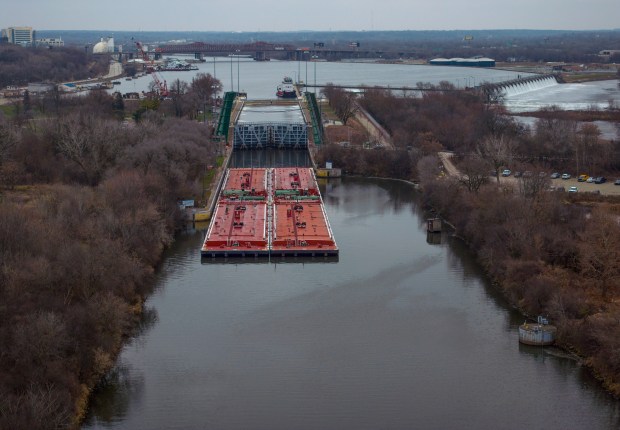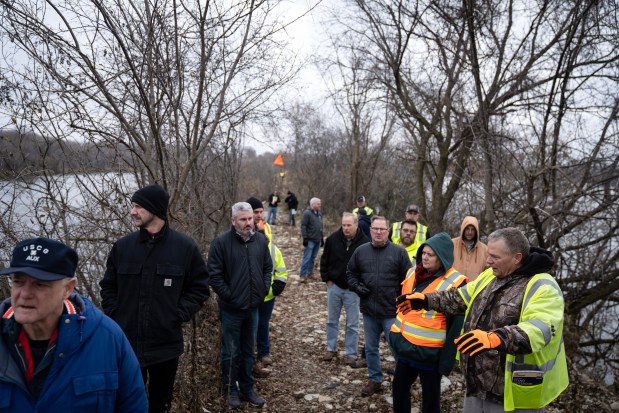After several months of back and forth, officials announced Monday that Illinois had signed a partnership agreement that will allow construction of the $1.15 billion Brandon Road Interbasin Project to begin with significant federal funding.
The effort, decades in the making, will become the last, multi-pronged line of defense to stop invasive silver and bighead carp from making it into Lake Michigan, where they pose a threat to Great Lakes ecosystems and billion-dollar fishing and boating industries.
The announcement comes after weeks of experts and advocates urging Gov. J.B. Pritzker to adhere to a June 30 deadline so that $274 million in federal funds wouldn’t be lost, and construction workers could take advantage of an upcoming scheduled closure of the lock and dam in Joliet.
Any more delays, they said, could have resulted in irreversible disaster if carp continued upstream in Illinois waterways and breached past electric barriers in Romeoville. If the agreement wasn’t signed, the U.S. Army Corps of Engineers’ Rock Island District — which oversees the project — wouldn’t have been able to continue allocating resources to pre-construction engineering and design.
“Protecting the Great Lakes has always been and will always be a priority for the State of Illinois and after many years of this project eluding multiple administrations, I am thrilled to see it move forward,” Pritzker said in a news release Monday. “Protecting the Great Lakes is not an undertaking that any one state or city can tackle alone, and I’m thrilled that we were able to forge a path that protects both the Great Lakes and ensures Illinois taxpayers do not shoulder a disproportionate share of the burden.”
The project has been awaiting approval from Illinois for a year, after the Michigan legislature authorized $64 million in June 2023 to help finance it. Those funds, plus $50 million from Illinois will account for the project’s required $114 million non-federal cost share.
“Complex agreements like this don’t happen in a vacuum, nor do they happen quickly,” said Natalie Phelps Finnie, director of the Illinois Department of Natural Resources. “A tremendous amount of effort over many months went into hammering out the details of this agreement. I’m thrilled this consequential project will now be able to move forward.”
In a mid-June virtual news conference, where a group of local politicians, stakeholders and experts gathered to ask the governor to take swift action, Executive Director Jennifer Walling of the Illinois Environmental Council said approving the project was an opportunity for Pritzker to secure his legacy as a “champion” of the Great Lakes and “critical interstate partner” to Michigan.
U.S. Sens. Dick Durbin and Tammy Duckworth, who have supported the project and helped secure federal funding, urged Pritzker to authorize the project in a June 25 letter.
“You have expressed concerns with Illinois taking on sole responsibility for a project that benefits the entire Great Lakes region, and we understand and share those concerns,” the letter read.
The federal government will pay 90% of the costs associated with the Brandon Road Interbasin Project’s construction, and just last month, the Illinois senators announced they had secured an increase in the federal cost share for operations and maintenance after construction to 90% as well.
Illinois and Michigan have also entered into a separate agreement to ensure any additional costs as the project continues are shared and do not fall disproportionately on either state’s taxpayers, the governor’s office said Monday.
Concerns about land acquisition and real estate at Brandon Road Lock and Dam presented a major obstacle, as privately owned land along the riverbank needed for construction is likely contaminated by a former coal plant.
Last year, experts told the Tribune negotiations would be complex; the state was hesitant to buy the property from energy company NRG, which owns the land, and bear the responsibility to ensure it was free of contaminants before passing it on to the federal government. Officials didn’t specify Monday how or whether these concerns have been ultimately resolved.
Now that the agreement has been signed, contracts for fabrication, continued design and bedrock removal are slated for solicitation from interested parties in the coming weeks.
The innovative, multipronged plan to install a “gantlet” or layered system at a “critical pinch point” in the Des Plaines River emerged from several years of collaboration among scientists, engineers and partners from numerous U.S., Canadian and tribal agencies surrounding the Great Lakes.

Invasive carp, particularly silver and bighead carp, pose a particular danger to aquatic life due to their large numbers and reproductive capacity. When they reach a new stream, river, lake or anywhere water touches, like wetlands, they can easily outcompete and starve native fish and mussels by eating all the plankton from the base of the food chain.
Under the project, when silver and bighead carp approach the lock and dam in Joliet they will first encounter an acoustic deterrent and an air bubble curtain. The bubbles will serve as a physical barrier and also remove small fish trapped under barges or carried in their wake.
The fish that make it past this curtain will then go through an engineered channel that will extend the length of the current lock, at the end of which persistent carp will come up against an electric barrier like the one in Romeoville. After that, an array of acoustic deterrents will keep the carp at bay by creating painful sound waves. On the other side, a flushing lock will send any remaining larval fish and eggs back downstream.
“Today’s agreement will help us get shovels in the ground as soon as possible on the critical Brandon Road project,” said Michigan Gov. Gretchen Whitmer on Monday. “The Great Lakes are the beating heart of Michigan’s economy, and Brandon Road will help us protect local communities and key industries, including fishing and boating, that support tens of thousands of good-paying jobs.”
In a news release Monday, the Alliance for the Great Lakes praised what they called a milestone agreement.
“The signing of the Brandon Road Project Agreement is historic and will help protect our fishery, our economy and quality of life,” said Marc Smith, policy director with the National Wildlife Federation. “Keeping invasive carp out of the Great Lakes is a national priority.”
For the last several decades since invasive carp were introduced to the country in 1963 and escaped into the Mississippi River Basin during flooding events in the 1980s and 1990s, dozens of other states have dealt with the havoc they wreak on aquatic ecosystems. Silver and bighead carp don’t have natural predators in American waterways and likely never will, which means their populations can grow unchecked.
In recent years, as the fish have continued spreading in the state’s waterways, Illinoisans frustrated with the pace of state and federal deterrent plans have taken matters into their own hands.
Some efforts focus on overfishing: The village of Bath’s Original Redneck Fishing Tournament pits amateurs and longtime anglers against each other in a yearly competition; commercial fishermen or “carp cowboys” round up fish elsewhere on the Illinois River; and state biologists have led large-scale removal efforts of hundreds of thousands of pounds of carp in a given day.
Other creative endeavors include using unmanned kayaks to gather information on large carp populations, and attempts to create a market for the fish as a food source, rebranding it as “copi” and cooking it in tacos, nuggets, empanadas and sliders.




